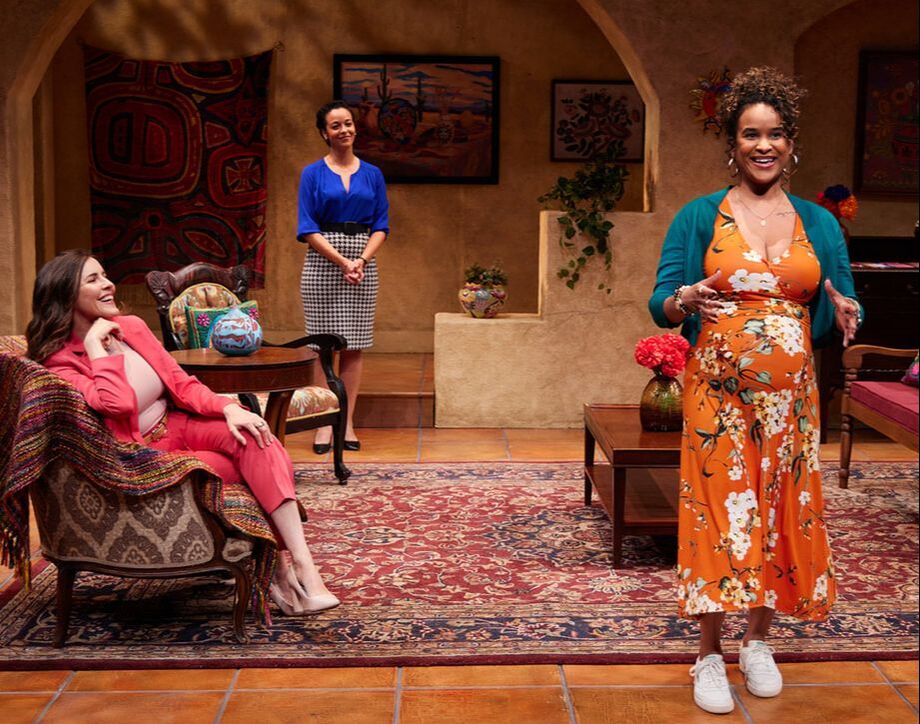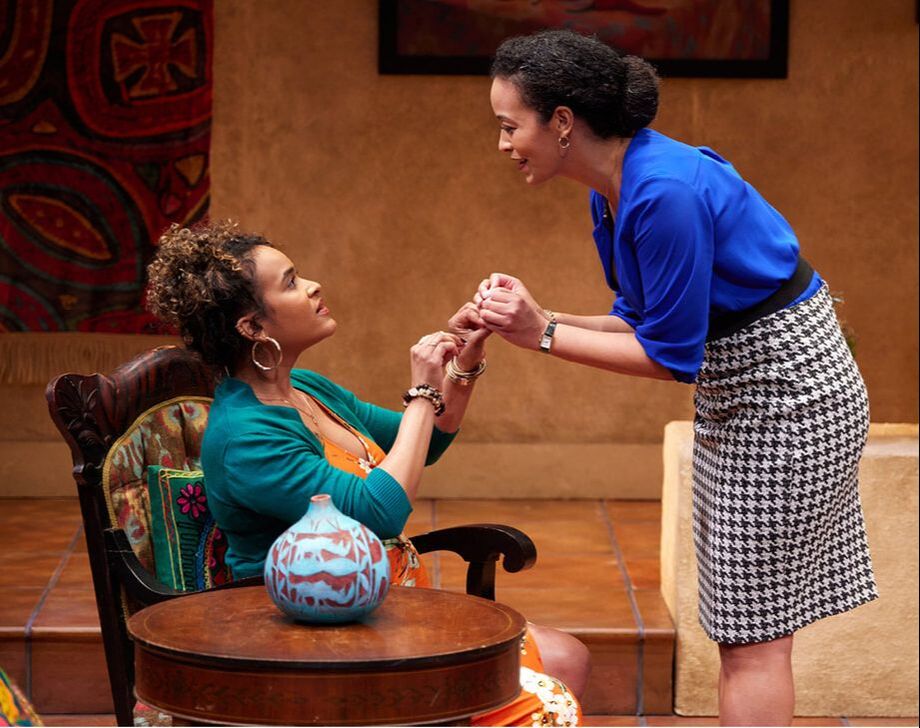Your source for Arts & Entertainment content, as well as fabulous human-interest stories, from Baltimore and beyond!
|
By Frankie Kujawa The Merriam-Webster Dictionary defines gentrification as “the process in which a poor area (as of a city) experiences an influx of middle-class or wealthy people who renovate and rebuild homes and businesses and which often results in an increase in property values and the displacement of earlier, usually poorer residents.” This idea of gentrification is explored in Baltimore Center Stage’s production of DREAM HOU$E by Eliana Pipes which runs through Sunday, May 15th. DREAM HOU$E explores the story of two Latinx sisters who guest star on an HGTV-style reality show in order to sell their family home in the rapidly gentrifying neighborhood of Hilo Villa. As they perform for the camera, one sister grapples with turmoil in the family’s ancestral past while the other learns how much she’s willing to sacrifice for the family’s future. Playwright Eliana Pipes and Director Laurie Woolery discuss the inspiration behind the performance and why this masterpiece will captivate Baltimore audiences. Frankie Kujawa: Eliana, in your own words, what can audiences expect from the production of DREAM HOU$E? Eliana Pipes (Playwright): I think audiences can expect a lot of surprises. I think they can expect to laugh. They can expect to think and to reflect about home. I think one big takeaway is for people who have a real strongly rooted sense of home and for people who also have a really sort of transient sense of home. The play brings up a lot of feelings of what home means, or maybe, whoever home means. Frankie Kujawa: As a director, what was important for you to focus on in regard to this piece? Laurie Woolery (Director): I love working on new plays! So being a ‘midwife’ to a playwright in 'birthing a play' feels like the ultimate honor and thrill because we don’t know anything other than this invitation. So, for me, the most important thing to focus on is Eliana’s vision and the story that she wants to tell. How we can play a role in clarifying [that story] by asking the right questions, and even by asking the wrong questions. Eliana deals a lot with metaphor in this play, and so taking an idea of an image and reflect on how to design it into being. There’s a very specific stage direction that says ‘The walls start to bleed.' So, this leads to thinking in terms of, ‘Ok, how do we make the walls bleed?’ This is very much a play that moves. Therefore, trying to figure out the pace of it, and honoring the pace of it while also not letting the audience get ahead of us or behind us. For me, as an artist, what’s always a goal is ‘How can I tell the most heart-centered, human centered, honest story possible honoring the people that are in the room – both the artists and the audience.’ Frankie Kujawa: Eliana, could you describe for readers what you hope they take away from this performance?
Eliana Pipes (Playwright): DREAM HOU$E is about two sisters selling a house in this gentrifying area. So, there are a lot of themes of place and space. My hope is that people leave the theater thinking differently about the spaces they occupy. The play is about space in the literal way, but the play is also about the spaces that we hold within ourselves and spaces that we hold for our communities. So my hope is that people leave thinking about both of those kinds of spaces. Frankie Kujawa: Laurie, could you describe for readers what you hope they take away from this performance? Laurie Woolery (Director): The price of selling your culture, and what that means both literally and emotionally. Recognizing that your culture is your ‘superpower.’ It doesn’t have to be tied to a specific thing, but it needs to be cherished; especially in a world that doesn’t always cherish things that don’t have a lot of economic value. Frankie Kujawa: Eliana, what was your inspiration for writing this piece? Eliana Pipes (Playwright): I grew up in a little pocket of Los Angeles that was rapidly transforming when I was a little kid. But, as a little kid, I couldn’t really understand the larger social forces that were in play in my city. Then, when I was thirteen, my family moved and we sold our house. We were privileged to have a house to sell in the first place, but that move was really complicated. On one hand, it was a huge gift for my family. We had a level of financial access that we didn’t have before, but at the same time that move meant leaving a community and leaving a sense of cultural belonging. So that was one big piece of what I was thinking. The other pieces was moving more into the professional world of playwrighting which has historically tended to be dominated by white men. I’m Black, white and Puerto Rican, and when I was writing for Black and Latinx characters and audiences I felt like I should be writing those characters and those stories in an environment where those populations aren’t always invited into the audience. I felt like I was being asked to sell cultural pain for money, And I wanted the money, and I wanted the acclaim. I wanted to be in those spaces anyway. So it was sort of reckoning with my own ambition and the sacrifices I made in the name of that ambition. That was also a big part of the inspiration for the play. Frankie Kujawa: Baltimore has definitely seen parts of its city and cultural heritages lost to gentrification. Why do you think that this piece may be important and relevant for Baltimore audiences? Laurie Woolery (Director): I fell in love with Baltimore! Just walking through the streets [of Baltimore], looking at the architecture and thinking about how history lives in these streets. When I was walking across some of those cobblestone streets I was thought, ‘How many people have walked across these streets?’ And it ties in perfectly with this play because at the cost of progress we lose our history. And we can lose our connection and our reminders. We don’t always, but we can. I find this happens more often because we want something newer or better or cleaner or posher. But, whereas I’m moving through the streets of Baltimore per se, I want to know the stories. I want to know what makes this city breathe. I want to know what is the engine behind it. And I don’t want to lose that with a new layer of concrete or a high-rise building that is taking over. So I feel like right now, especially over these last couple of years where people have been placed in their homes, that the benefit and downside of that is people are turning more to the simple things and the relationships that they have with one another. I’m also really hungry for people of color in Baltimore to come and see this show. There’s something about this play that everyone can relate to, however there are so many Easter eggs in there for people of color who will recognize the desire for growth, ambition, progress and generational wealth. You know, our parents have worked very, very hard for each generation to get better and progress more, but at what cost? So, I would really love the community to show up and see this show, and have that conversation among each other. Eliana Pipes (Playwright): This play is a triple co-production. It started in Atlanta, GA, had a stop in Connecticut and now it’s here [in Baltimore]. And, in each of those cities there has been a very similar dynamic. Each of these cities, just like almost every city in America, is grappling with gentrification. There’s that neighborhood that everyone knows is ‘on the cusp.’ So, it’s been so present in these conversations that we’ve had in each location. We’ve talked about this fact in the rehearsal room a lot, and the fact is that the play can’t stop gentrification. I sure wish that it could, but it can’t. So, the task of the play becomes about resilience and healing. To think about, ‘what can we wish for these sisters and for ourselves?’ For more information, please visit: www.centerstage.org/
0 Comments
Your comment will be posted after it is approved.
Leave a Reply. |
Archives
January 2024
Categories
All
|



